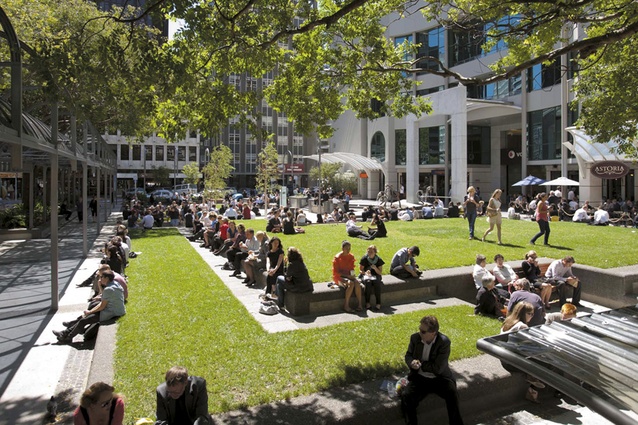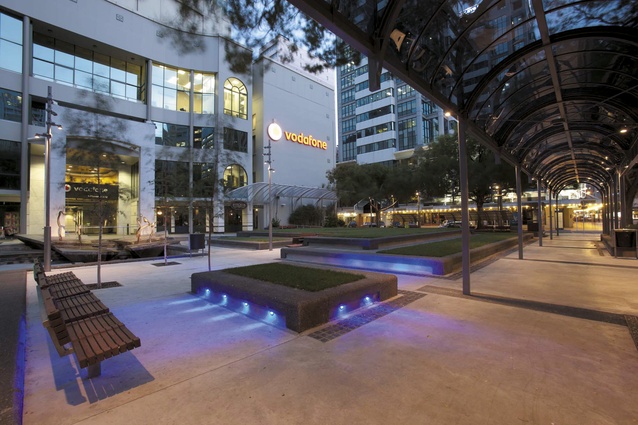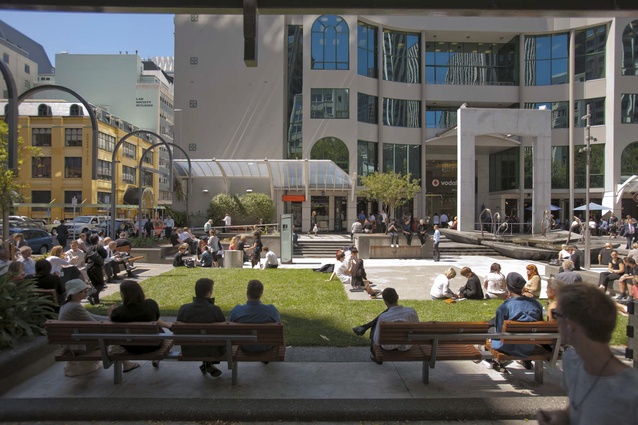Charles Gordon’s look for Wellington
Wellington City Council landscape architect Charles Gordon recounts the history behind a much-loved inner city park, and its subsequent reinvigoration.
The Midland Park site was purchased by Wellington City Council (WCC) in the late ’70s as a future park for the city. Originally the site of the Spanish-styled Midland Hotel, it was to be the first in a string of parks to run through the city. At that time, landscape Architect Ron Flook was working for the Wellington City Council, and was asked to design the new Midland site. He used a style similar to late-’50s and ’60s American plaza design. Materials included surfaces of both plain and exposed concrete, use of terraces to provide seating, grass to promote relaxation, a curved glass canopy with lighting to walk under and a large waterfall at the back of the park as a central focus. These features were typical and in style with the plazas and open spaces of cities around the world in this era. This Wellington park was built in 1983 at a cost of $80,000. In 1995, the Midland on the Park building was built on the old Police Building site. The boundary of the park and the new building was the focus for the entry to the new proposed high-rise building. A great deal of negotiation was undertaken by the WCC with the developers of the time, to ensure that Midland Park did not just become a front door for the new building. The rear wall waterfall was replaced with a new fountain in the centre of the park at this time. The areas adjoining the new building were designed to fit with the existing park elements. As part of a long term infrastructure replacement plan, Midland Park was last year listed for review and upgrade. Initially, it was thought that a complete redesign of the park was most appropriate, but after much discussion within Council, value was identified in what already existed. An approach of retention became the focus, and the idea of a ‘refresh’ was born.
Respecting the past
As a background, there is the topic of how we treat our older open spaces in Wellington. Heritage is a term most often associated with buildings. Great lengths are gone to ensuring that we go from documenting to complete retention of parts of or whole buildings. This doesn’t often apply to our open spaces. Midland Park was not ‘old’ in real terms, but it was initially seen to have passed its use-by date.
This has happened to a number of older parks around the city in the last few years. Addressing Midland as ‘heritage’ seems misplaced yet a heritage approach was much more applicable. The design assessment identified that the park design was important and should be retained. Design solutions were to include use of existing materials and patterns wherever possible. And when finished, the park should be readily identifiable as the Midland Park everyone knew and loved.
The assessment of the park identified areas that both worked well and many that didn’t. Much of the infrastructure, including lighting, seating and other features, were old and problematic. Access to the interior of the park was awkward and there were drainage issues, most notably in the large area of grass on the north side and within the pool and pump areas.
New solutions included providing a widened access into the park by removing some of the lawn area and creating a straight walk-through. A portion of the old lawn became an island and new seating area. In conjunction with this, a section of one of the front gardens was removed. This allows a spacious entrance. The canopy has been modified in this area to accommodate the changes on the ground. The low-lying grass area on the north side with poor drainage has been raised, creating a similar grass area with new walls for sitting. Virtually all the ground surfaces have been replaced using the concrete patterns that were in the original park. Lighting technology has changed dramatically from when the park was built and new lighting addresses this with spots on the pools, downlighting through the canopy and a focus on the new small island at the entrance.
Refreshing the scene
Midland Park has been a green oasis in the central CBD since its creation. With the trees at maturity, it presents an enclosed green room that people migrate to throughout the day to escape offices and the hard urban surfaces of the city. The trees and gardens create an environmental island within the city, attracting multitudes of birds and pedestrians. Many bike stands and adjacent bus stops provide good access to the public transport networks and provides an easy place for cyclists to stop and relax.
The ‘refresh’ of Midland Park has sensitively addressed issues confronting an aging but loved central city park. By focusing on the positive elements of the park and enriching them, and renewing older infrastructural items including lighting and plumbing, the park is now set for another 25 years of good service. This approach of retaining and enhancing rather than removal and total redesign has acknowledged Midland Park’s original design and its importance in the city fabric as a special public space.












